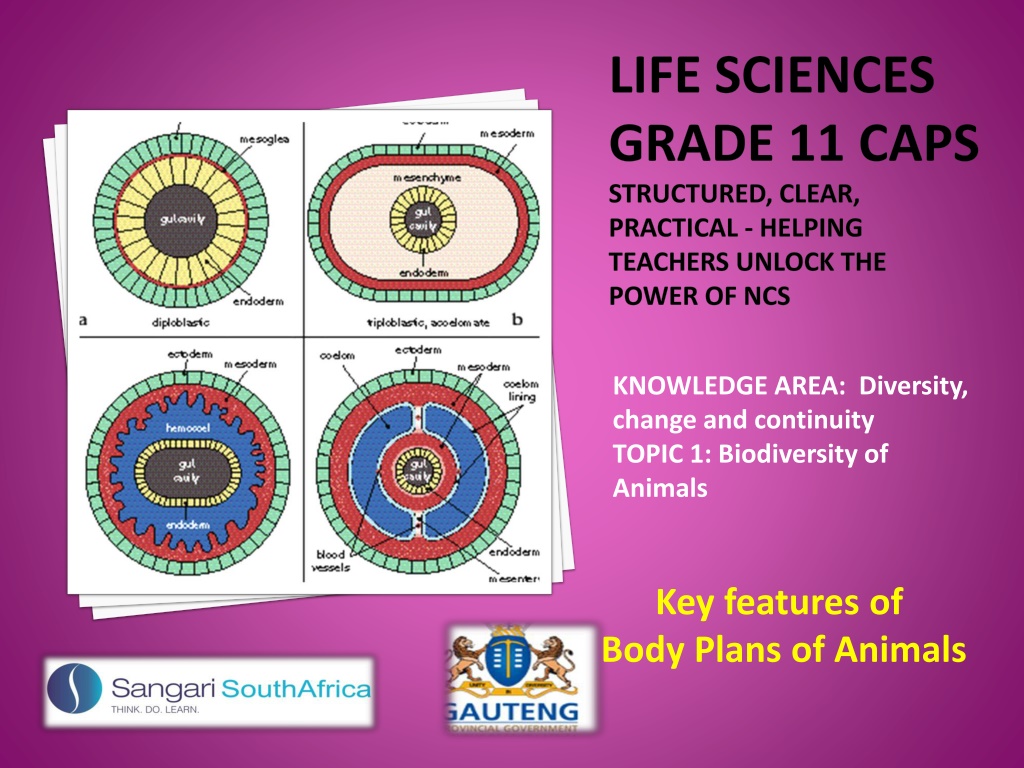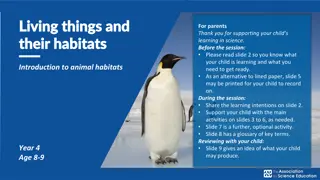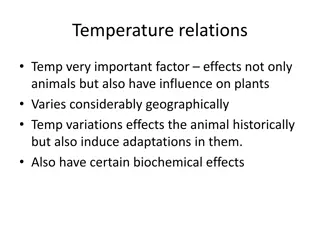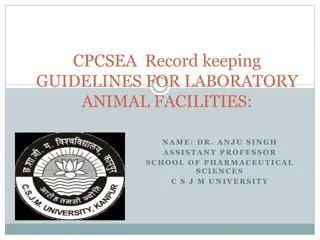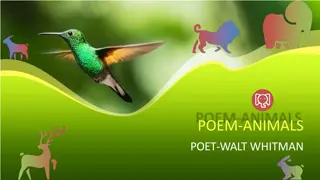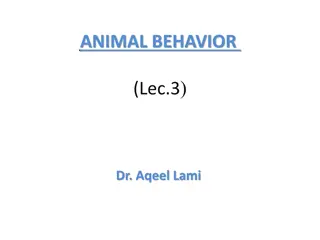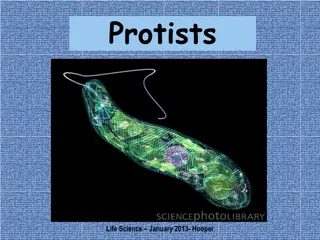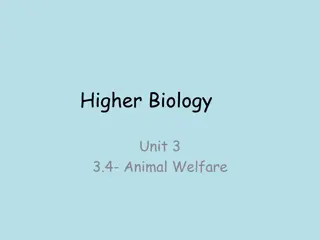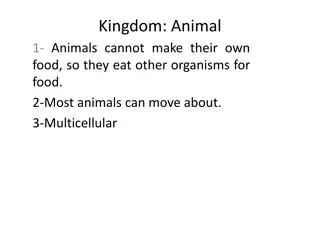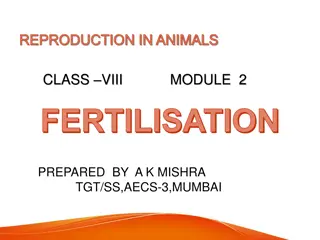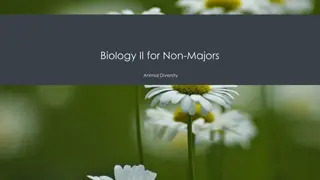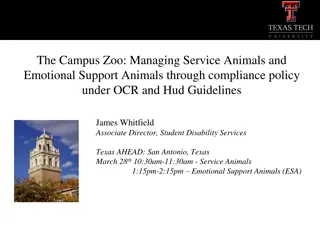Understanding Body Plans of Animals in the Animal Kingdom
Introduction to the diverse phyla within the Animal Kingdom, highlighting key features of body plans such as symmetry, cephalization, tissue layers, coeloms, and gut types. Exploring the classification system through common characteristics shared within phyla and the significance of morphology in grouping organisms.
Download Presentation

Please find below an Image/Link to download the presentation.
The content on the website is provided AS IS for your information and personal use only. It may not be sold, licensed, or shared on other websites without obtaining consent from the author. Download presentation by click this link. If you encounter any issues during the download, it is possible that the publisher has removed the file from their server.
E N D
Presentation Transcript
LIFE SCIENCES GRADE 11 CAPS STRUCTURED, CLEAR, PRACTICAL - HELPING TEACHERS UNLOCK THE POWER OF NCS KNOWLEDGE AREA: Diversity, change and continuity TOPIC 1: Biodiversity of Animals Key features of Body Plans of Animals
SUMMARY OF PRESENTATION The term phylum Introduction to the Animal Kingdom Key features of the body plans of animals Symmetry and Cephalisation Number of Tissue Layers in Embryo Coeloms and blood systems Type of Gut based on Number of Openings
PHYLUM: Do you remember the 5 kingdoms that all living organisms are classified into? They are: Monera Protista Fungi Plantae Animalia Organisms are classified according to certain common characteristics, for example all the prokaryotes belong to the Kingdom Monera. 1. 2. 3. 4. 5.
PHYLUM: However we find that all the organisms in the kingdom are not identical. They do have some differences. Therefore within each kingdom there are many large groups. These large groups are called phyla. (singular phylum) The organisms that belong to a single phylum share some common characteristics. But the organisms that belong to each phylum are not identical as well.
INTRODUCTION TO THE ANIMAL KINGDOM The next slide shows you all the phyla of the animal kingdom.
INTRODUCTION TO THE ANIMAL KINGDOM Phylum Porifera Phylum Cnidara Phylum Invertebrates Platyhelminthes Phylum Nematoda Kingdom Animalia Phylum Annelida Phylum Mollsuca Phylum Arthropoda Phylum Echinoderma Phylum Chordata Vertebrate
INTRODUCTION TO THE ANIMAL KINGDOM This year we will only look at the body plan of 6 phyla. These are: Porifera Cnidara Platyhelminthes Annelida Arthropoda Chordata. 1. 2. 3. 4. 5. 6.
KEY FEATURES IN RESPECT OF BODY PLANS OF ANIMALS. Morphology and development are the features that are often used to classify organisms into groups. Morphology refers to the external and internal structural characteristics. The morphological and developmental characteristics that are used for classification are as follows: Symmetry and cephalisation. Number of tissue layers. Coelom and blood systems. 1. 2. 3.
KEY FEATURES IN RESPECT OF BODY PLANS OF ANIMALS. Number of openings in the gut. The combination of a set of morphological and developmental characteristics into a functioning organisms is referred to an organism s body plan. The body plan of organisms can be used to determine its level of complexity. Or we can say to determine its level of organization. 4.
SYMMETRY AND CEPHALISATION Symmetry is when an organism can be divided into 2 identical halves. Some organisms do not have a regular shape. Therefore these organisms do not have any symmetry. We call them asymmetrical, like the sponges shown alongside.
SYMMETRY AND CEPHALISATION Animals that have a circular or radial body plan show radial symmetry. Radial symmetry is when the animal can be cut along any vertical plane through the centre to form two identical halves, for example the sea anemone shown alongside.
SYMMETRY AND CEPHALISATION Animals that show radial symmetry have no heads or tails. In other words they do not have posterior or anterior ends. Remember we mentioned earlier that their body parts have a circular arrangement, this means that all their body parts even the sense organs are evenly distributed through out the body. This allows the animal to sense danger and food from any direction. This means that they will be able to react to danger coming from any direction.
SYMMETRY AND CEPHALISATION Radial symmetry is very important to animals that do not move. Since it allows the organism to sense food and danger from any direction and to react to food or danger from any direction. These animals that do not move are called sessile. Radial symmetry is also important to the planktonic animals that drift or swim weakly in the water.
SYMMETRY AND CEPHALISATION Some animals can be cut into 2 identical halves in the central longitudinal plane. This is called bi-lateral symmetry. This means that the animal can be cut from the top of the ventral surface to the bottom of the dorsal surface into 2 identical halves. Animals in the phylum Platyhelminthes, Annelida, Arthropoda and Chordata show bi-lateral symmetry.
SYMMETRY AND CEPHALISATION Animals that show bi-lateral symmetry have 2 important developments over other organisms. The sense organs are accumulated at one end of the body. The end that has the sense organs is called the anterior end and the opposite end is called the posterior end. This means that the anterior end is different from the posterior end. So the animal now has a definite anterior and posterior end.
SYMMETRY AND CEPHALISATION The accumulation of sense organs at one end of the body is referred to as cephalisation. Cephalisation lead to the development of a central nervous system. The second development that led to bi-lateral is the differentiation of the upper and lower surfaces. The upper surface is the ventral surface. The lower surface is called the dorsal surface. Different dorsal and ventral surfaces is known as dorso-ventral differentiation.
SYMMETRY AND CEPHALISATION The presence of dorso-ventral differentiation and cephalisation meant that these organisms have definite left and right sides. Organisms with bi-lateral symmetry are able to crawl, burrow, swim and fly. This type of movement needs to be co-ordinated by a complex nervous system.
SOMETHING FOR YOU TO DO: Name and explain the development that lead to bi-lateral symmetry.
SOLUTION: The two developments that led to bi-lateral symmetry were: The accumulation of sense organs at one end of the body. This is known as as cephalisation. The differentiation between the dorsal and ventral surfaces. This is called dorso-ventral differentiation. 1. 2.
NUMBER OF TISSUE LAYERS: Here we are talking about the number of tissue layers that develop in the embryonic stage. Remember that the zygote that is formed during sexual reproduction is made up of 1 cell only. The zygote needs to develop into a multicellular organism. Once it becomes multicellular then the cells need to differentiate so that the different organs and the tissues needed by the body can develop.
NUMBER OF TISSUE LAYERS: But before differentiation occurs the cells need to become arranged into layers. These layers are called the germ layers. Sometimes in some organisms the cells arrange themselves into two layers. gut These 2 layers are an outer layer called the ectoderm and an inner layer called the endoderm. Diploblastic organism Animals that have only 2 germ layers are called diploblastic. Can you name some diploblastic animals?
SOLUTION: They are sea anemones, blue bottles and jelly fish.
NUMBER OF TISSUE LAYERS: In some animals there are 3 germ layers. The ectoderm and endoderm are separated by a middle layer called the mesoderm. Animals who have 3 germ layers are called triploblastic. All bi-laterally symmetrical animals are triploblastic. Triploblastic animal
NUMBER OF TISSUE LAYERS: Ectoderm gives rise to the outer covering of the organism. In some cases it also gives rise to the central nervous system. The endoderm gives rise to the gut lining and all the organs that arise from the gut. The mesoderm gives rise to the muscles and most of the organs that are found between the digestive tract and the outer body covering.
COELOM AND BLOOD SYSTEMS Diploblastic animals do not have body cavities. They only have a gut as shown in the picture alongside. The gut is not a body cavity. A body cavity is a fluid space found between the digestive tract and the ectoderm. This body cavity is called a coelom. GUT
COELOM AND BLOOD SYSTEMS There are 2 types of coeloms. These are true coeloms and pseudocoeloms. A true coelom is a body cavity that is surrounded by mesoderm as shown in the diagram alongside. Some triploblastic animals such as vertebrates, annelids and arthropods have coeloms. Animals that have true coeloms are called coelomates.
COELOM AND BLOOD SYSTEMS However some triploblastic animals do not have true coeloms. These animals have body cavities that are lined by mesoderm on one side only. This type of body cavity is called a pseudocoelom.
COELOM AND BLOOD SYSTEMS Animals that do not have either type of coelom are called acoelomates. The animals found in the phylum Platyhelminthes are examples of acoelmates.
COELOM AND BLOOD SYSTEMS FUNCTIONS OF A BODY CAVITY: The body cavity creates space for the development of internal organs. It separates the gut wall from the body wall so that each wall can function independently. The fluid found within the body cavity acts as a skeleton. This type of skeleton where the muscles contract and relax against a fluid is called a hydrostatic skeleton. The fluid also act as a cushion for the organs, preventing injury.
COELOM AND BLOOD SYSTEMS The separation of the gut wall from the body wall also means that the distance between the two walls has increased. This means that diffusion is no longer an effective means of transport. It also means that excretory waste can no longer simply diffuse out of the body.
COELOM AND BLOOD SYSTEMS These problems were solved in the following way: A transport system was developed to transport gases from the body wall to the gut wall because some animals (earthworm) used the skin as a gas exchange surface. The transport system is also used to transport food from the gut wall to the body wall. 1. An excretory system was developed to get rid of nitrogenous waste. 2.
NUMBER OF OPENINGS IN THE GUT BLIND GUT: What is it? Some animals have a gut with only 1 opening. This opening is usually called the mouth. Food enters and undigested food leaves the body through the same opening. This type of gut is called a blind gut. Cnidarians and some free living Platyhelminthes are some examples of animals with a blind gut.
NUMBER OF OPENINGS IN THE GUT BLIND GUT: Disadvantages: Since the digested and undigested food enters and leaves through the same opening, there is a mixing of the digested and undigested food. This occurs because the digested and undigested food moves in 2 directions. This means that the gut cannot become specialized. That is the gut cannot have separate regions for separate functions.
NUMBER OF OPENINGS IN THE GUT THROUGH GUT: What is it? Some animals have a gut with 2 openings. These 2 openings are called a mouth and anus. The food enters the animal through the mouth and undigested food leaves the body through the anus. This means that food travels in 1 direction only, it enters through the mouth and leaves through the anus. This type of gut is called a through gut.
NUMBER OF OPENINGS IN THE GUT THROUGH GUT: Advantages: Since the food moves in only 1 direction specialization of the gut can occur. The different regions become adapted (specialized) for different functions. This allows for digestion to occur all the time, even when ingestion and egesting occurs. This lead to greater efficiency.
TERMINOLOGY: Phyla: Large groups of organisms with similar characteristics within the kingdom. Morphology: refers to the external and internal structural characteristics. Body plan: refers to the combination of a set of morphological and developmental characteristics into a functioning whole. Symmetry: is when an organism can be divided into 2 identical halves. Asymmetrical: refers to an organism with no symmetry.
TERMINOLOGY: Radial symmetry: is when the animal can be cut along any vertical plane through the centre to form two identical halves. Sessile: these are animals that do not move. Bi-lateral symmetry : refers to animals can be cut into 2 identical halves in the central longitudinal plane. Cephalisation: refers to the accumulation of sense organs at one end of the body. Dorso-ventral differentiation: is when the dorsal and ventral surfaces of the organism are different from each other. Diploblastic animals: are animals that have only 2 germ layers.
TERMINOLOGY: Triploblastic animals : are those who have 3 germ layers. True coelom: is a body cavity that is surrounded by mesoderm Pseudo-coelom: refers to body cavities that are lined by mesoderm on one side only. Acoelomate: are animals that do not have coelom. Hydrostatic skeleton: is a type of skeleton where the muscles contract and relax against a fluid. Blind gut: is a gut with only 1 opening Through gut: is a gut with 2 openings
QUESTION 1 Animals that have an irregular shape are A. Symmetrical B. Radially symmetrical C. Bi-laterally symmetrical D. Asymmetrical
QUESTION 2 That animals that have a regular shape maybe A. Symmetrical B. Asymmetrical C. Both A and B D. None of the above
QUESTION 3 Accumulation of sense organs at one end of the body is called A. Dorso-ventral differentiation B. Cephalisation C. Radial symmetry D. None of the above
QUESTION 4 A gut that has 2 openings is called A. Stomach B. Intestine C. Blind gut D. Through gut
QUESTION 5 _________ leads to bi-lateral symmetry A. Through gut and blind gut B. Acoelomate and coelom C. Cephalisation and dorso-ventral differentiation D. A and B only
QUESTION 6 Dorso-ventral differentiation refers to A. Cells that have been differentiated B. Cells that are still meristematic C. A dorsal surface that is different from the ventral surface D. Organisms that show bi-lateral symmetry.
QUESTION 7 A through gut allows for 1. mixing of food 2. differentiation to occur 3. food to move in one direction A. 1 & 3 B. 3 & 2 C. 1 & 2 D. 1 only
QUESTION 8 The disadvantage of presence of a coelom is A. The animal becomes larger B. Diffusion can no longer be used as a transport system C. Food travels in 1 direction only D. None of the above
QUESTION 9 The fluid space that lies between the digestive tract and the outer wall and is lined by the mesoderm on one side only is the A. Coelom B. True coelom C. Pseudocoelom D. gut
QUESTION 10 A fluid filled space that lies between the gut wall and the outer wall and is surrounded by the mesoderm on one side only is the A. Coelom B. True coelom C. Pseudocoelom D. Gut
QUESTION 11 Animals which arise from 2 germ layers are A. Acoelomate B. Diploblastic C. Triploblastic D. A and B
QUESTION 12 Animals that arise from 3 germ layers are A. Acoelomate B. Diploblastic C. Triploblastic D. A and B
